How I Learned not to Dig
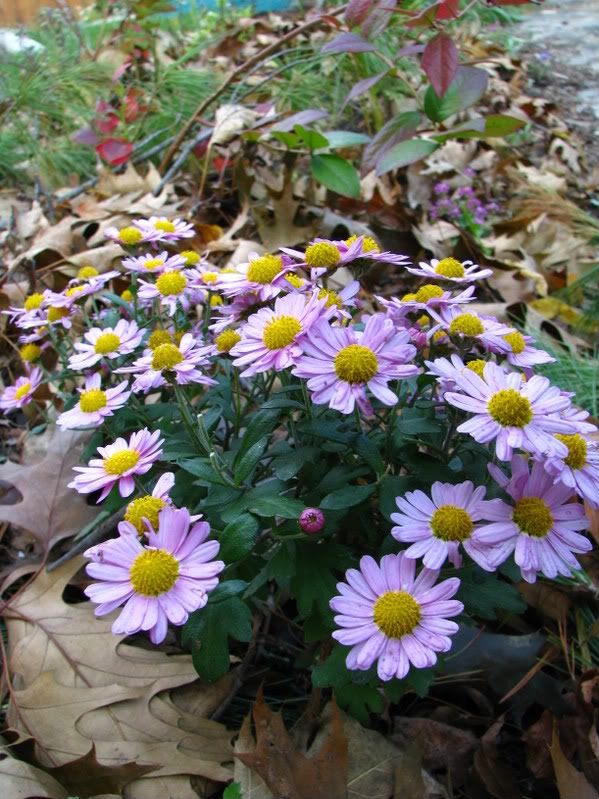
Thought we'd start off with a pretty flower picture. Here is a blueberry patch that includes edible and decorative plants in part shade. It was created and is maintained using no-dig techniques. Blueberries especially appreciate the moisture retentive nature of a rich, organic soil. They are topdressed mostly with pine needles and oak leaves, both of which help to create the acid soil blueberries need.
Almost all my gardens have been created using simple techniques variously described as Lasagna Gardening, No-Dig Gardening, Hay Barrel Gardening etc... My first couple veggie patches, however, were created by laborously removing clumps of sod and weed roots, double digging, ammending with compost, peat and other recommended nutrients then carefully smoothing this even mixture until the crumbs of soil were as small as a pea and as flat topped as can be. I had heard about mulching to prevent weed growth and diligently did so which worked so I started reading more about mulching only to discover that I might not need to dig afterall.
Next year, I expanded my dimunitive 12x8 foot veggie patch to an expanded 20x40 feet. This took one day. It was early in the spring and the sod had yet to green up. A truck dumped 10 cubic yards of dirt onto my driveway, eliciting giggles from the neigbhours. I cut the outline of where the garden was going to go, all the while my hubby watched carefully to see if I stepped outside of the negotiated boundaries. Then wheel barrow by wheel barrow we dumped dirt 4-6 inches high. I shaped beds, and planted. Voila - a garden.
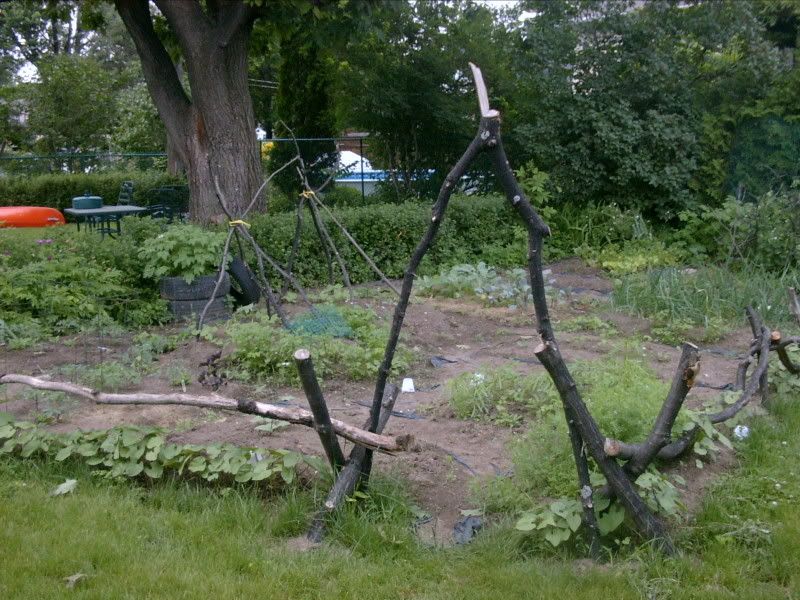
Shortly after the making of my first huge, no dig bed. My neighbour was cutting back his oak tree so I inherited some braches for fencing.
Did I get weeds? Some but very few and yes there were creeping bellflower, dandelion and violet in the yard. I pulled these when I saw them but mostly I dealt with the abundant growth of the garden enabled by the breaking down of the sod underneath and the imported seeds in the soil like mustards and lamb's quarters. P.S. I now know that all the seeds mentioned in this paragraph are edible.
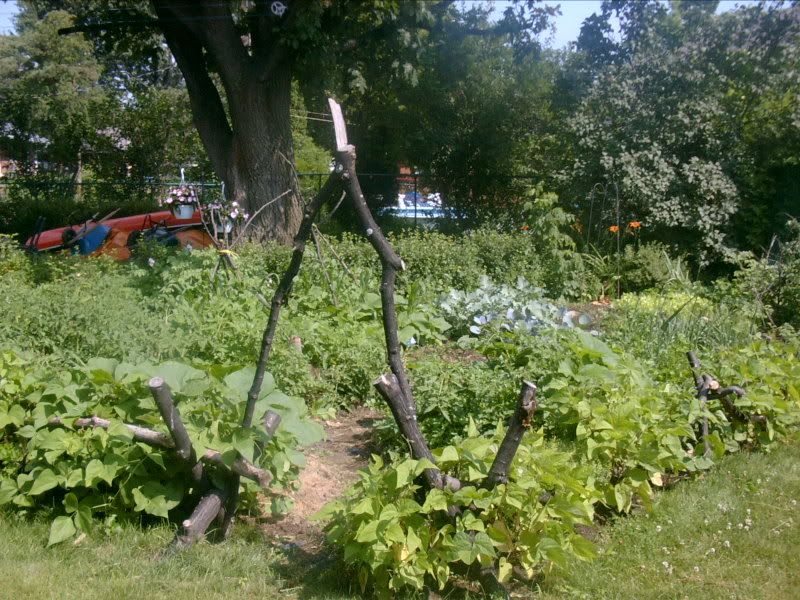
Abundance in the garden, several months later. Note the grass clippings used as mulch on the path.
From then I've advanced this technique to use a number of top dumped materials such as fall leaves, compost, manure and other organic mulches. I've also used cardboard or newspaper over the sod before dumping on my dirt ingredients but unless there was a serious weed problem, this doesn't seem necessary. In fact, in the case of really invasive weeds, I tend to remove as much as I can then smother with plastic for a season before trying to plant a new bed.
The First Steps
The best time to do this is either in the fall or early spring.
It is great fun marking up lawn. Determine where you want your garden and then take a spade and make a dotted dig line around the edge. Some people like to use hoses or flour or spray paint sold for this purpose but I find that turning over a clump of dirt all along the line is easiest. If you decide you don't like it, you can just plop the sod back into place, firm it down with your foot and try again.

My front lawn is south facing and huge which is just asking to turned into a garden. Now only 1/3 remains as green concrete. I used no dig methods for all of it. Here you see on the left a new bed being put in. I tossed the sod strips from the edge on top of the bed though this makes it somewhat uneven for covering purposes. I recommend that you put the extra sod in your composter.
Put on your gardeners goggles and stare at the line you have dotted from all angles. If you like it than dig out one shovel depth in between your dig dots, smoothing out curves and straightening lines as you go. It may help to use a sticks and string to keep your straight lines straight. If you want really clean curves, even circles, then use a stick with a string marked at a certain length. Position your stick in the ground so that the outer edge of the circle or semi-circle falls where you want it and then stretch the string tight to the mark in various places around the edge of your design to dig out the dotted curve.
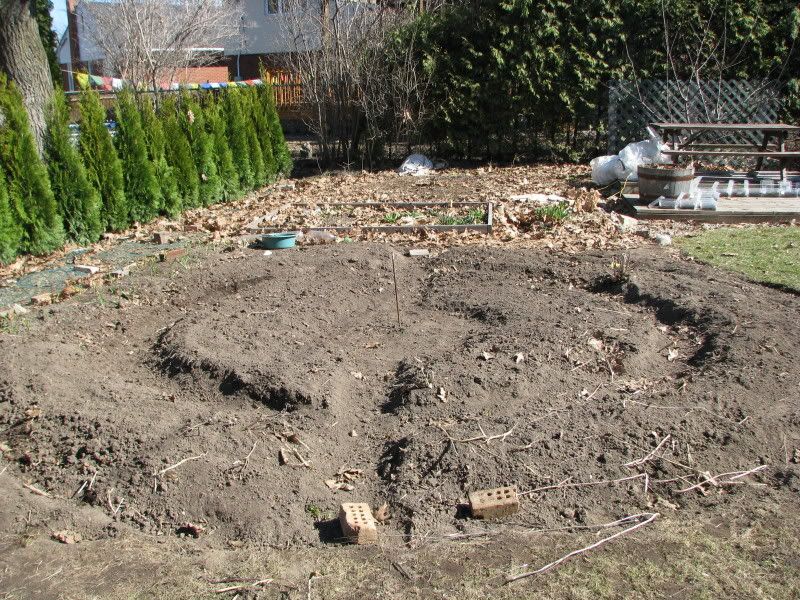
This circular veggie patch was made using a tall stick in the middle with a rope tighed to it and secured so it wouldn't ride up the stick. It was knotted in two places and the path it travelled round the stick marked at each 'wide' circle. Then a foot out from the mark to make the pathes.
Once you have cut out your line, cut out one space width of sod all around the edge. I promise, we'll stop digging soon. You can choose at this point to lay down overlapping black and white print newspaper (though most colour prints on regular newspaper are safe too) or cardboard. If you use cardboard, I recommend punching holes with a pitch fork every foot or so to allow for better drainage while it's breaking down. Wet down this material.
At this stage, you can also dig out areas for pathes that will have drainage or other support or lay down landscaping cloth in areas that will not be mounded with dirt ingrediants. If you are not using paper or cardboard, and the sod is out of dormancy, then cut the grass really short. Obviously you can use this time to put in any side supports such as stones or wooden beams to make a raised garden.
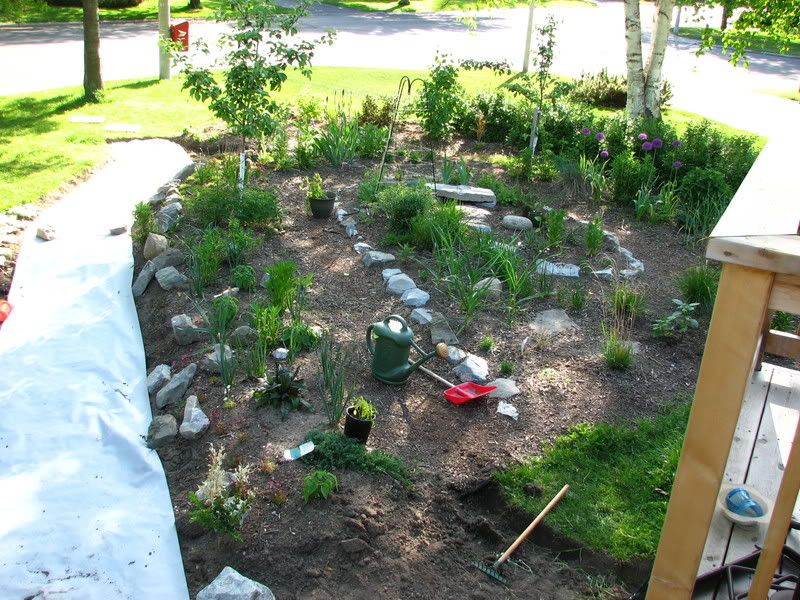
Landscaping cloth being laid for a simple gravel and patio stone path.
Now, either over your 'paper' or over bare sod, start laying down your organic matter. I recommend a couple inches of soil first but anything will do. Remember different materials will tend to make the soil more or less acidic such as pine needles (more acidic), bone dust (less acidic). It helps to think of this as sheet composting so ideally you would be layering both green, fresh material and brown, dry material. If using mostly dirt, compost and manure, then a layer of 4 inches does me well. Just make sure you are amply burying your grass (hence cutting it really short to begin with). If you are using mainly loose materials like leaves, make an 8-12 inch layer. Really there is no boundry on height just make sure you add enough to occult any light from getting to the sod beneath.
If you are using both dirt like materials (compost, dirt, well composted manure) and loose materials (hay, grass clippings, leaves), put the dirt materials in the bottom and leave the dry materials on top to act as mulch.
You can plant right away but I'd give it a couple of weeks for the sod to start to break down beneath. If you do plant right away, then cut away the sod clumps underneath, filling these holes with some sort of dirt. Make sure that no sod is exposed to light.
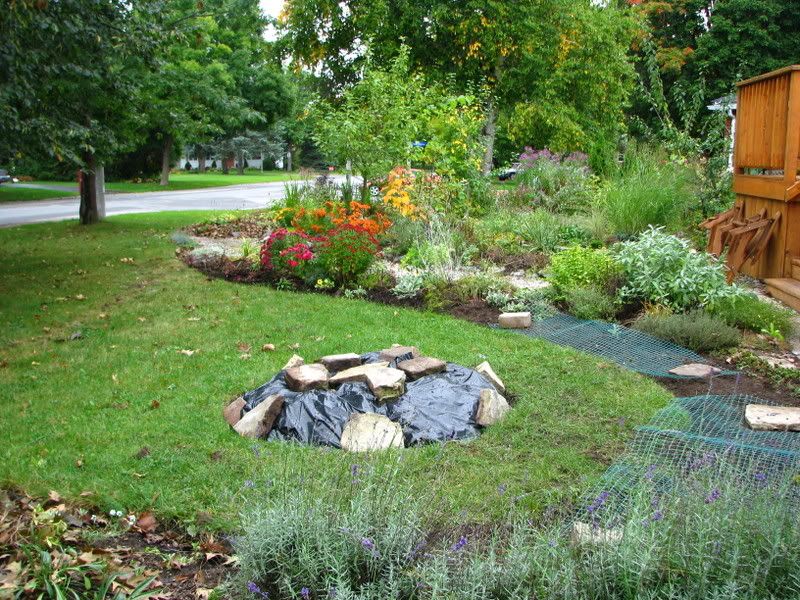
Small circular garden created by piling the sod from the edge and covering with plastic from fall to spring. After the plastic was removed, it was planted and mulched. You can see some additional expanded beds nearby with plastic netting ontop to prevent squirrels from stealing freshly planted bulbs. The garden in the background is the bed that was being cut in the above picture.
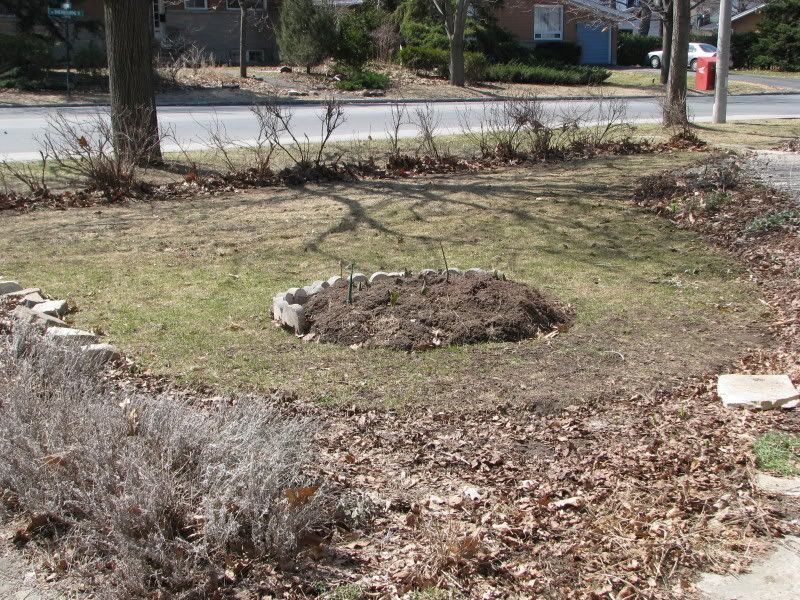
Spring following year, notice the sod is gone.
If you don't have enough materials to make a bed right away, then you can always lay cardboard over the area you want to plant the following year. Weigh this down with something like boards, stones etc... and cover with what you have. Keep adding organic matter as it comes to hand. Wait until things get growing next spring and then plant.
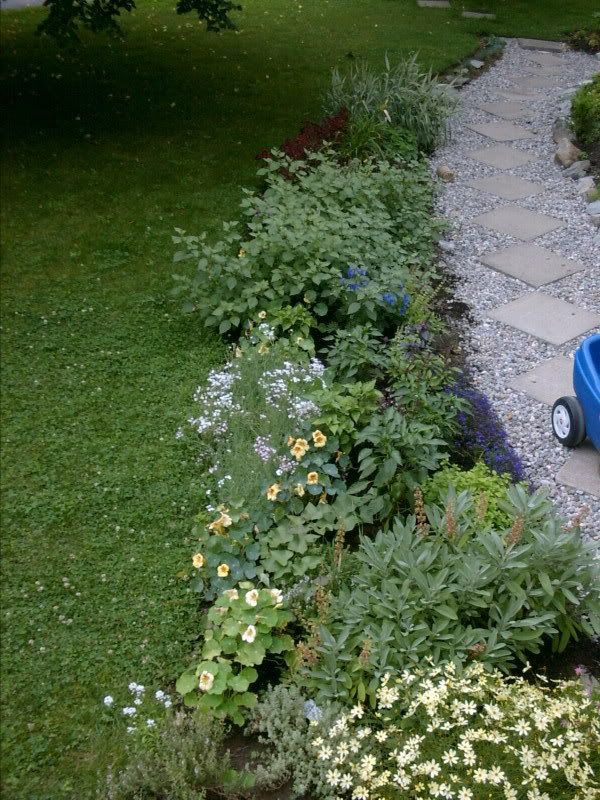
Left side of front spiral garden. Several months after creation.
The Second Steps
If this is a dirt garden, you can scatter seeds and plant. Once things are up and growing, mulch around the plants to lower weed growth. If you already have 'mulch' material on top, then you can make planting holes by moving aside some mulch, putting in a plant with ample dirt around it. Once it's up and growing, move the mulch in closer. You can also create seeding blocks by moving aside mulch and adding dirt / compost then seeding on top.
Once the organic matter breaks down, you should continue to topdress your garden with whatever materials become handy like straw, leaves, green clippings (without the seed heads or invasive stems/roots - think mint which can root along the stem unless you want a bed of mint of course), maures etc... The layer of material not broken down thins quickly in our garden so planting and making seeding blocks becomes as easy as pushing aside the 1-3 inches of whole matter and digging in the rich organic earth or seeding atop it.
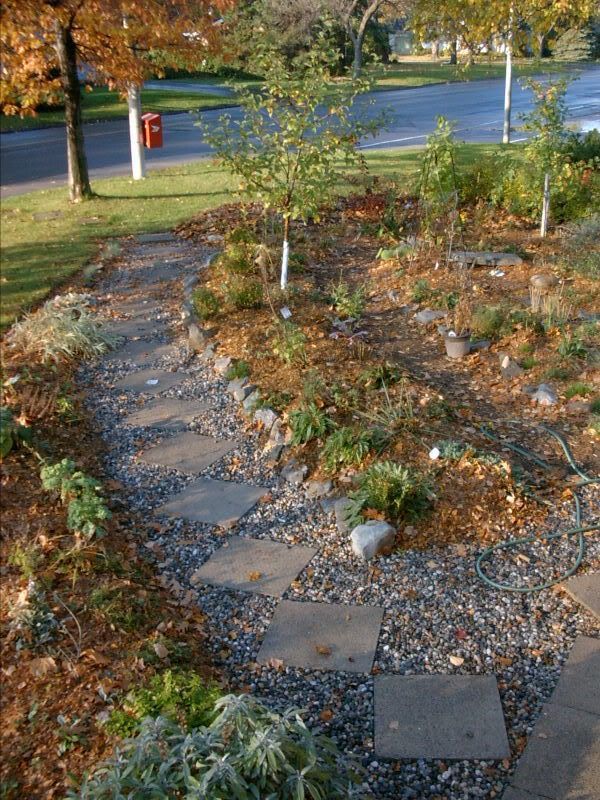
Fall leaves applied as mulch. You can run your lawn mower over them to break them down a bit first.
I let many of my plants self seed which they normally do without a problem even into a thin mulch layer and add new material only after the seedlings are up and growing for a few weeks.

The husband topdressing with compost - I'll make a gardener out of him yet!
Annual weeds become few after awhile unless you stir the soil by digging out potatoes or add new material that contains them. Thankfully a lot of these weeds like purslane and plantain are edible so I weed into a salad strainer. Anything that I am not going to eat, I toss atop the garden mulch to break down unless it will spread that way. If you don't like any weeds in your garden then dig out the perennial weeds when you find them or move aside the mulch and lay down a layer of cardboard on top of that area, pushing the mulch back overtop. For really tenacious weeds, you may need to use black plastic. Alternatively, you can just cut them back when they start to out compete your veggies.
Next week - Specific Veggies and the No Dig Method

8 comments:
YES! No more digging!
Our soil is laden with rocks and impossible to till. Thanks for the tutorial, I'll get that veggie garden up yet!
This does not work if you have Bermuda grass, though. That nasty invasive stuff _has_ to be dug and pulled and taken out. If you chop it, you get more. I wish I could lasagne! It looks as though it works really well for you. Terrific!
Some weeds are really hard, which is why I recommend digging them out or smothering if you do have those problems. In fact, I've read for those weeds with runners that will reproduce even more if cut, the best technique is baking/smothering with black plastic. I have done this with some weeds, though mostly I do dig really invasive weeds out such as Lily of the Valley and Chinese Lantern though I've been told by gardening gurus that a combination can also work: dig and then smother/bake with plastic for a couple seasons. Might work!
Abbey: Are you gardening on rock or just with rocky soil?
great post... what if you want to plant carrots the 2nd year... they need really loose soil. will you till to prep?
I've got a good layer of organic matter built up now making the soil very friable so carrots, parnips etc... can grow quite deep without hinderance. I also tend to overwinter carrots in the ground (I get a large loss rate) after examining them.
Initially I used to use trenches with more organic matter infilling or rebar cones with sandy organic infill for large roots like parsnips. I do have friendly soil though.
I found your blog from your comment about leaves in garden beds for mulch. I love your garden. I think that the best gardeners do the least work for the results they want - hence: why rake all of the beds? I have been gradually removing lawn all over my yard for the past 10 years (think I'd be done by now), and have used many techniques. We don't have a cold winter so things grow all year. I have sheet mulched, and just used organic mulch, cutting off the irrigation, and had lots of success. Today I dug out St. Augustine grass from an area of about 30 sq. ft. Hurts my back, but it is simple, effective and fast. Love your blog.
I'm afraid I've become a bit of a sceptic on this method too, after trying it for several years. We have quite a few very persistent weeds (including mares tail) and I've found that even after cardboard and six inches of mulch, the weeds got through again by midsummer. By the following spring the garden had returned to turf.
It's great for potatoes grown with surfaces sowing and then covered with lots of mulch, but for most other things I found it multiplied the weed problems later as the fertile soil got them really going.
I've now gone back to narrow beds which are carefully weeded in the first instance but then deep mulched as often as possible.
I guess the answer must be to have masses of mulch material available, and we could never find enough or had the time to haul it in.
Post a Comment